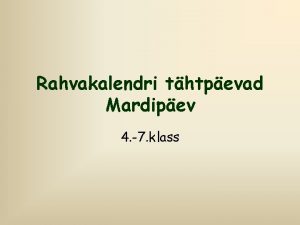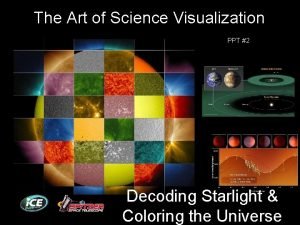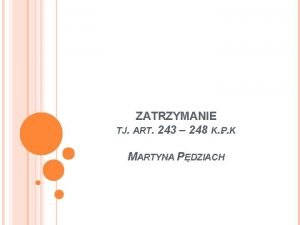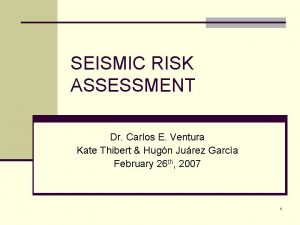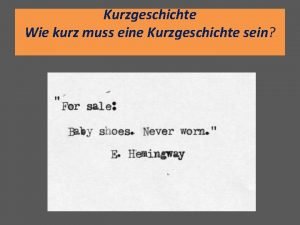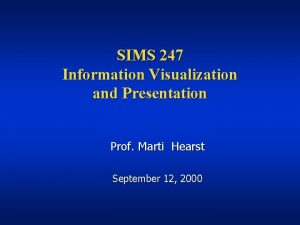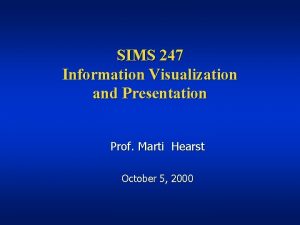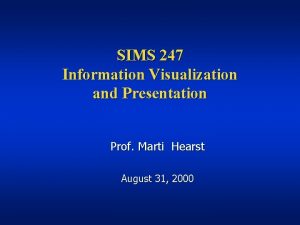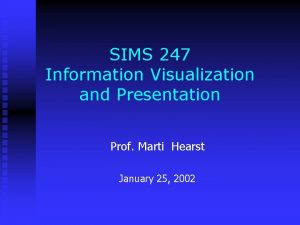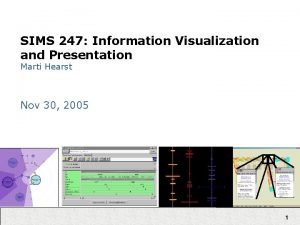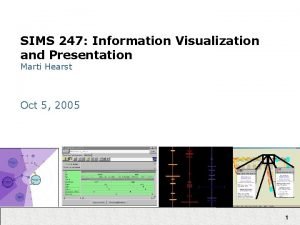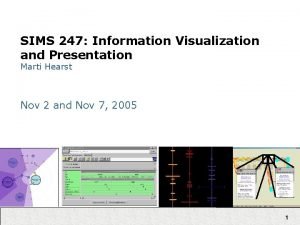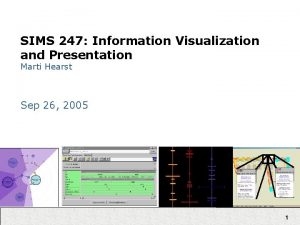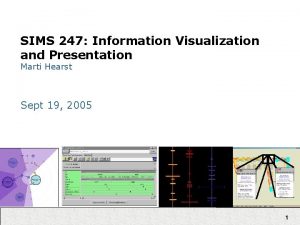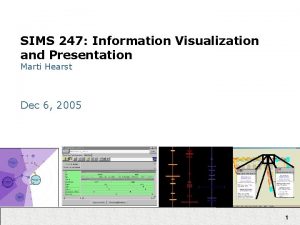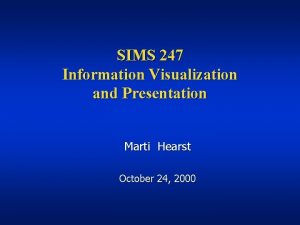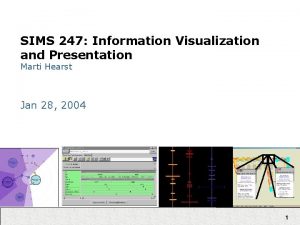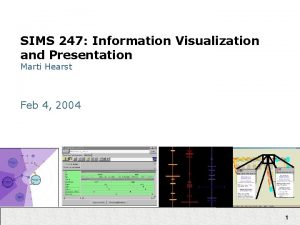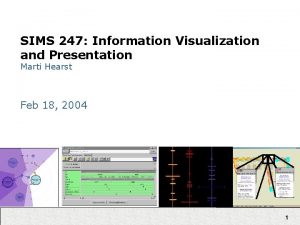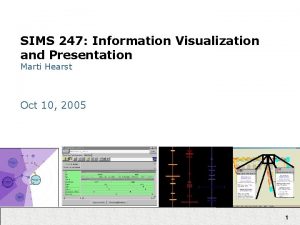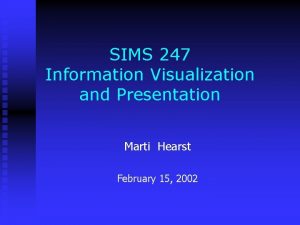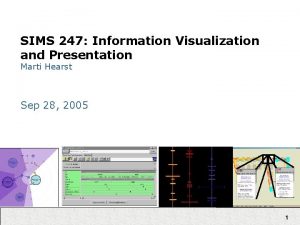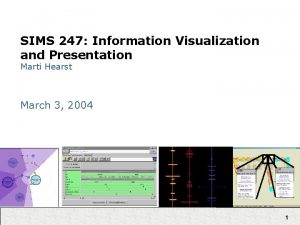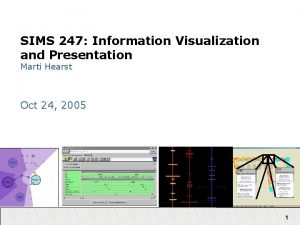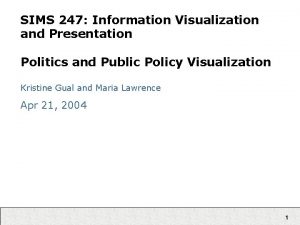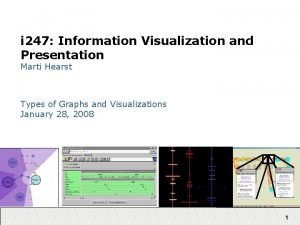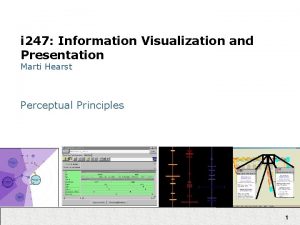SIMS 247 Information Visualization and Presentation Prof Marti



























- Slides: 27

SIMS 247 Information Visualization and Presentation Prof. Marti Hearst August 31, 2000

Last time: Trees and Graphs (Show PARC Information Visualizer Video)

File Systems as Trees: The Treemap (Shneiderman)

A Good Use of Tree. Maps and Interactivity www. smartmoney. com/marketmap

Analysis of Tree. Maps on Stock Market Overviews • • • How does this succeed? How does it fail? How can it be improved?

Information Visualization, Chapter 1 • Mapping from reality to images • Mapping from images to mental models – Example: London Underground Map, invented by Henry Beck in 1931 – What is interesting about this?

London Underground Map From Transport of London

London Underground Map, closeup of central London From Transport of London

Geographic tourist map of London, including bus lines From Transport of London

Idealized Transport Maps • Intuition: – “When you are underground, it doesn’t matter where you are. ” • User focus of attention can depend on goals – Particular departure and destination stations + route – Main transfer points • Opposite of most visualization problems – Going from geographic to abstract!

Map modified with fare zones

Geographic bus map of London From Transport of London

Using Visualization for Analysis • • Data validation Outlier detection Suggestion and evaluation of models Discovery of relationships among subsets of data

Case Study: Space Shuttle Disaster by Edward Tufte (Visual Explanations, 1990) • • Visualization for Explanation Main point: – The data about the problem was available, but – The data was not presented in a convincing way

Tufte’s Challenger Disaster Example 0 4 8 12 Number of damaged O-rings 55 65 75 Temp (F) at time of launch

Tufte’s Challenger Disaster Example 0 4 8 12 Number of damaged O-rings 25 35 45 55 65 Temp (F) at time of launch 75

Information Visualization, Chapter 2 • Rearrangement and Interaction – “A graphic is never an end in itself: it is a moment in the process of decision making” » Bertin 1981 – “Graphing data needs to be iterative because we often do not know what to expect of the data. ” » Cleveland 1985

Tukey on EDA • From “High Interaction Graphics” by Gary wills: – According to Tukey EDA is about "looking at data to see what it seems to say" (p. v). "It is detective work - numerical detective work - or counting detective work - or graphical detective work". (p. 1) and "Unless exploratory data analysis uncovers indications, usually quantitative ones, there is likely to be nothing for confirmatory data analysis to consider" (p. 3). For Tukey, the burden of discovering information in the data falls on EDA, whereas the burden of proving that the information is not spurious falls on the traditional data analysis methods.

Tufte’s Notion of Data Ink Maximization • What is the main idea? – draw viewers attention to the substance of the graphic – the role of redundancy – principles of editing and redesign • What’s wrong with this? What is he really getting at?

Tufte • Principles of Graphical Excellence – Graphical excellence is • the well-designed presentation of interesting data – a matter of substance, of statistics, and of design • consists of complex ideas communicated with clarity, precision and efficiency • is that which gives to the viewer the greates number of ideas in the shortest time with the least ink in the smallest space • requires telling the truth about the data.

Tufte Principle Maximize the data-ink ratio: Data-ink ratio = data ink -------------total ink used in graphic Avoid “chart junk”

Tufte Principles • • • Use multifunctioning graphical elements Use small multiples Show mechanism, process, dynamics, and causality • High data density – Number of items/area of graphic – This is controversial • White space thought to contribute to good visual design • Tufte’s book itself has lots of white space

Tufte’s Graphical Integrity • Some lapses intentional, some not • Lie Factor = size of effect in graph size of effect in data • Misleading uses of area • Misleading uses of perspective • Leaving out important context • Lack of taste and aesthetics

From Tim Craven’s LIS 504 course http: //instruct. uwo. ca/fim-lis/504 gra. htm#data-ink_ratio

How to Exaggerate with Graphs from Tufte ’ 83 “Lie factor” = 2. 8

How to Exaggerate with Graphs from Tufte ’ 83 Error: Shrinking along both dimensions

The Importance of Rearrangement • Examples from IV book, Chapter 2 – Crops data – Eye/hair color data – Titanic data (also Chapter 3)
 Mardipäeva ilmaennustus
Mardipäeva ilmaennustus Sims student information management system
Sims student information management system Translate
Translate Introduction to information visualization
Introduction to information visualization Information visualization
Information visualization Money247
Money247 Usf 247
Usf 247 562-247-8422
562-247-8422 562-247-8422
562-247-8422 Cs 247
Cs 247 24 cfr part 247
24 cfr part 247 247 craps
247 craps Uml module
Uml module 700 e yuvarlanan en küçük sayı
700 e yuvarlanan en küçük sayı Yoursafezone 247
Yoursafezone 247 Module 1. stl sequential containers
Module 1. stl sequential containers 243 kpk
243 kpk Econ 247
Econ 247 Jose marti ubc
Jose marti ubc Zemaite marti pagrindine mintis
Zemaite marti pagrindine mintis Luni marți miercuri joi vineri sâmbătă duminică
Luni marți miercuri joi vineri sâmbătă duminică Liebesgewinsel
Liebesgewinsel Gary marti
Gary marti Marti reinfeld
Marti reinfeld Posakiai apie knygas
Posakiai apie knygas Marti a. hearst
Marti a. hearst Escola jaume balmes sant martí sarroca
Escola jaume balmes sant martí sarroca Direkte personencharakterisierung
Direkte personencharakterisierung
